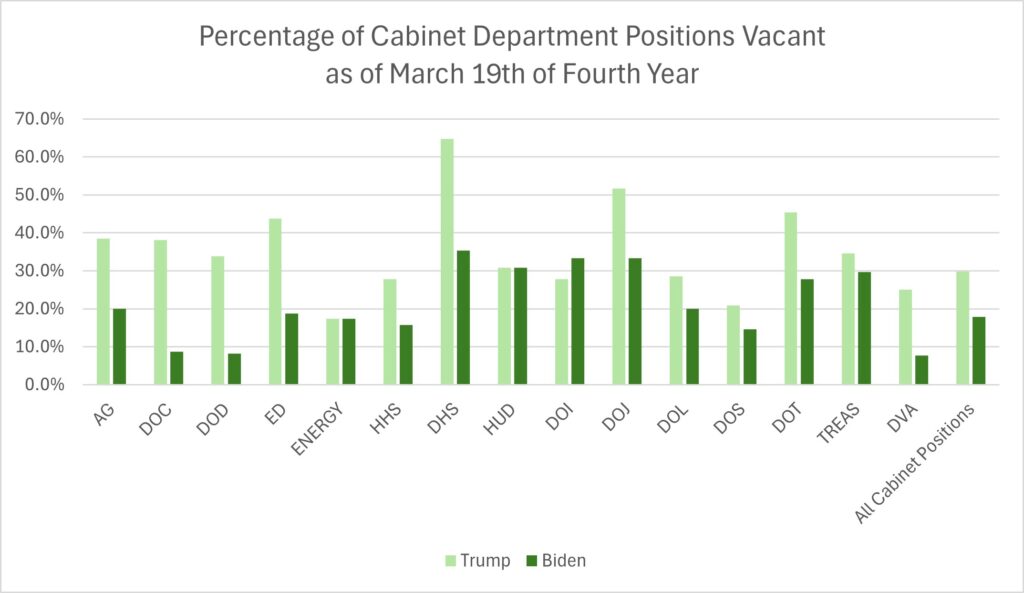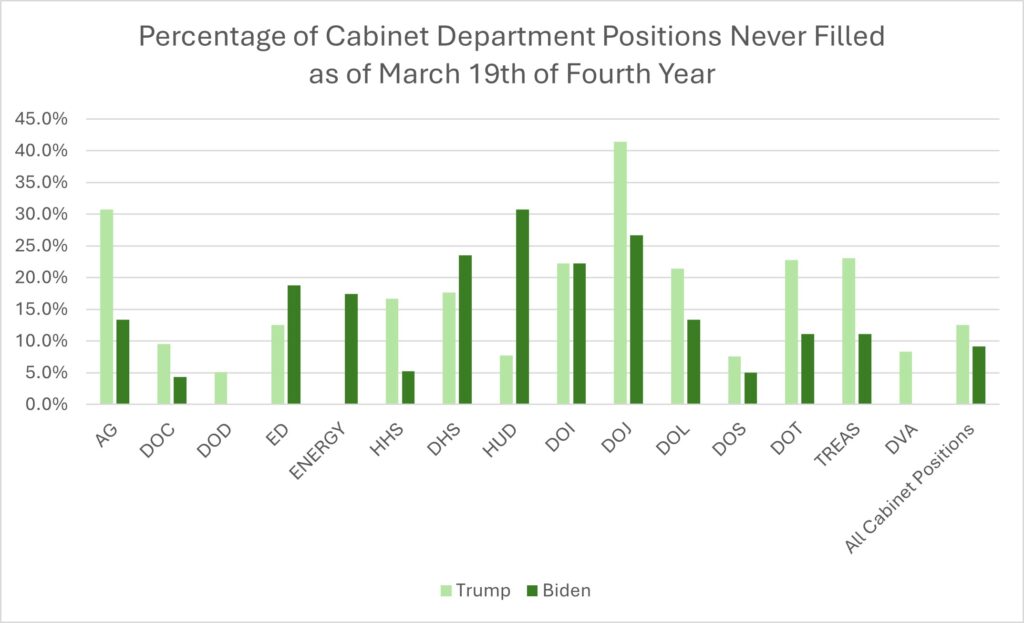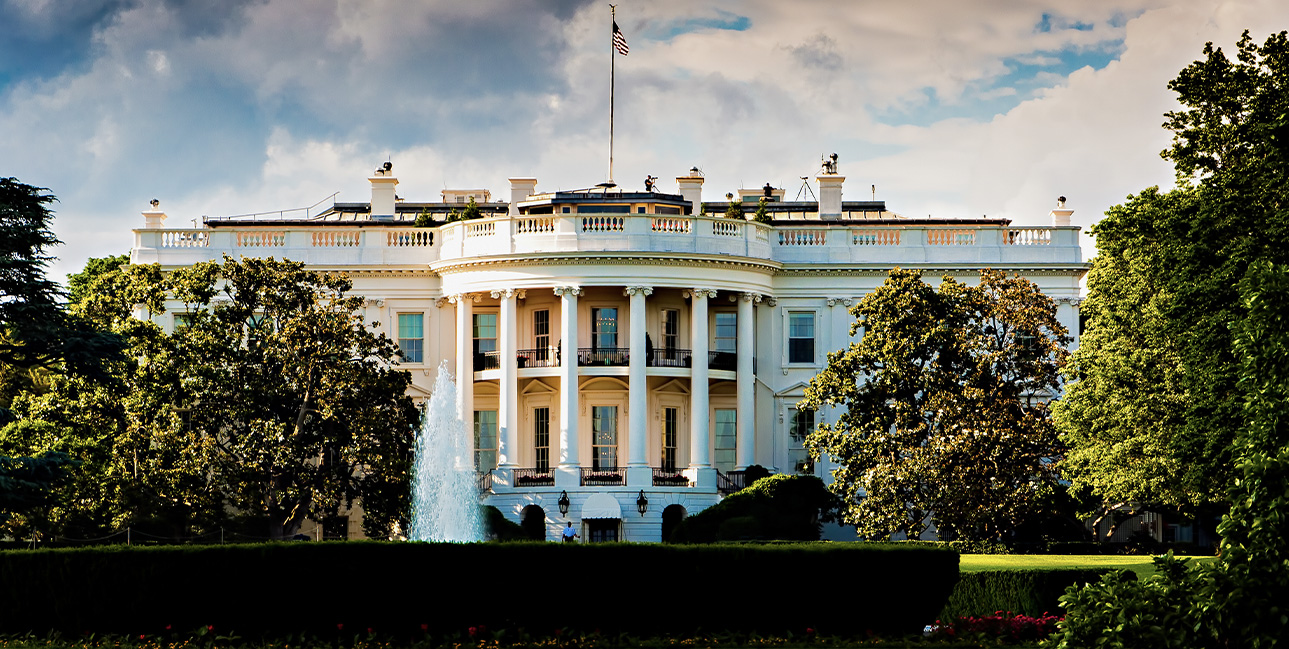Blog
April 25, 2024
Taking stock of the vacancy crisis across cabinet departments
The Senate confirmation process for executive branch nominees has become more difficult during the last 40 years.
President Joe Biden’s nominees have taken nearly three times longer to be confirmed during his first three years compared to the nominees in the George H.W. Bush administration.
Confirmation delays continued to grow under the Trump administration and have worsened further under Biden. Delays faced by Biden’s nominees in the first three years were 13% longer than Trump’s nominees.
Beyond confirmation times, presidents during the last 40 years have seen fewer and fewer of their nominees confirmed by the Senate. Through year three, Presidents Donald Trump and Biden each had approximately 150 fewer nominees confirmed compared to President Barack Obama and 250 to 300 fewer nominees confirmed compared to Presidents H.W. Bush, Bill Clinton and George W. Bush.
The broken process leaves critical positions vacant for long periods of time, which is a disservice to the public in carrying out the fundamental roles of government, from national security to infrastructure to health and safety.
Using an analysis of our Political Appointee Tracker, we have been able to gain a clearer view of vacancy rates under the Biden and Trump administrations.
From our analysis of the state of vacancies in Cabinet Departments as of March 19th in the fourth year of the last two administrations, we found that:
Vacancies are widespread across Cabinet departments
As of March 19, 2024, 98 of 547 Cabinet department positions (18%) followed on our tracker were vacant in the Biden administration. At the same point in time, 157 of 526 Cabinet department positions (30%) followed on our tracker were vacant during the Trump administration.
Some Cabinet departments have alarmingly high rates of vacancies
Four Cabinet departments had 30% or more of their positions vacant as of March 19, 2024. At the equivalent date during Trump’s fourth year, nine Cabinet departments had 30% or more of their positions vacant. For both administrations, the Department of Homeland Security had the highest vacancy rate at 35% in the Biden administration and 65% in the Trump administration. The departments of Housing and Urban Development and Justice also have consistently had high rates of vacancies, totaling more than 30% across the last two administrations.

Many Cabinet positions have yet to be filled more than three years into last two administrations
As of March 19, 2024, 50 Cabinet positions (9%) had never been filled with a Senate confirmed appointee since the beginning of the Biden administration. At the same point in time, 66 Cabinet positions (13%) had never been filled with a Senate confirmed appointee since the beginning of the Trump administration. The Department of Justice has been particularly affected by this problem, with over 25% of Senate confirmed positions never having someone confirmed by the Senate through March 19 of the fourth year of the last two administrations.

Nineteen Cabinet positions were not filled by either the Trump or Biden administration by March 19 of their fourth year
Across the Trump and Biden administrations, there are 19 positions in common that remained vacant during the first three years of each administration. Four of these positions are the chief financial officers at the departments of Agriculture, Homeland Security, State and Treasury. The list also includes high-level positions like the director of Immigration and Customs Enforcement.
Positions Not Filled by the Fourth Year of Each of the Last Two Administrations
| Position | Agency |
|---|---|
| Chief financial officer | Department of Agriculture |
| Assistant secretary for civil rights | Department of Agriculture |
| Assistant secretary for communications and outreach | Department of Education |
| Assistant secretary for planning and evaluation | Department of Health and Human Services |
| Chief financial officer | Department of Homeland Security |
| Director, Immigration and Customs Enforcement | Department of Homeland Security |
| Assistant attorney general for the tax division | Department of Justice |
| Deputy administrator, Drug Enforcement Administration | Department of Justice |
| Commissioner, U.S. Parole Commission (2) | Department of Justice |
| Special counsel for immigration-related unfair employment practices | Department of Justice |
| Chairman, Foreign Claims Settlement Commission | Department of Justice |
| Chief financial officer | Department of State |
| Coordinator for threat reduction programs | Department of State |
| Ambassador, Bahamas | Department of State |
| Ambassador, Cuba | Department of State |
| Director, Office of Surface Mining Reclamation and Enforcement | Department of the Interior |
| Special trustee for American Indians | Department of the Interior |
| Chief financial officer | Department of the Treasury |
These findings highlight the challenges in filling certain key roles in government. Reform of the confirmation process is urgently needed, starting with a reduction in the number of appointments subject to Senate approval.
Chris Piper is a manager at the Center for Presidential Transition.



